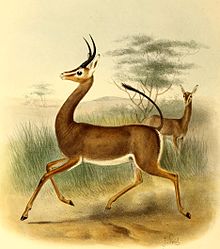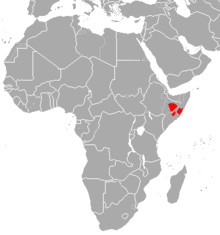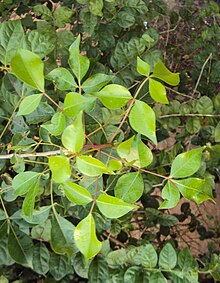Dibatag
| Dibatag | |
|---|---|

| |
| Scientific classification | |
| Domain: | Eukaryota |
| Kingdom: | Animalia |
| Phylum: | Chordata |
| Class: | Mammalia |
| Order: | Artiodactyla |
| Family: | Bovidae |
| Subfamily: | Antilopinae |
| Tribe: | Antilopini |
| Genus: | Ammodorcas Thomas, 1891 |
| Species: | A. clarkei
|
| Binomial name | |
| Ammodorcas clarkei | |

| |
| Dibatag range | |
The dibatag (Ammodorcas clarkei), or Clarke's gazelle, is a medium-sized slender antelope native to Ethiopia and Somalia. Though not a true gazelle, it is similarly marked, with long legs and neck. It is often confused with the gerenuk due to their striking resemblance. The typical head-and-body length is about 103 to 117 cm (41 to 46 in). They stand up to about 80 to 90 cm (31 to 35 in). Male dibatag weigh between 20 and 35 kg (44 and 77 lb), whereas females range from 22 and 29 kg (49 and 64 lb). The length of the curved horns, present only on males, is typically between 10 and 25 cm (3.9 and 9.8 in). The upper parts are gray to fawn, while the dorsal and lateral areas are cinnamon to rufous (reddish brown). The underparts, rump and the insides of the legs are all white. While markings are visible on the face, there are none on the flanks or the buttocks.
Dibatag are alert and secretive, and their brown coat provides an excellent camouflage, making the dibatag one of the antelopes most difficult to hunt. They are diurnal animals, and navigate in very small herds. Both sexes attain sexual maturity at 12 to 18 months. The species is polygynous. After a gestational period of six to seven months, a single offspring is born. Parturition usually occurs from September to November. The lifespan typically averages 10 to 12 years. Dibatag may maintain temporary territories demarcated by preorbital gland secretions, urine or feces. Primarily browsers, the dibatag feed on foliage and young shoots and shrubs. Dibatag are well adapted to semi-arid habitats, with the capability of surviving on very little or no water.
Several factors including human settlement, habitat degradation, large numbers of livestock, political unrest and armed conflicts in the areas covering its range and lack of conservation measures for two to three decades in the late 20th century have now reduced the population to only a few thousand. Significant populations still occur in southern
Taxonomy and etymology
The dibatag was first
The dibatag, which holds its black tail straight up when it is fleeing,
Description

The dibatag is a medium-sized

The species has a small, flat, pointed, wedge-shaped head with large eyes and medium-sized ears. A similarity to the gazelles is the black, branched structure in the interior of the ears. The mouth is very small and the upper lip slightly elongated. There are strong facial markings resembling those of a gazelle. A chestnut brown streak runs from the crown up to the nostrils along the nose, flanked on both sides by parallel white stripes that circle the eyes. A white spot marks the throat. The soft and smooth coat is gray to fawn in the upper parts. The ventral side, rump and the insides of the legs are completely white, and the flanks and the buttocks are unmarked.[6][9]
The dibatag closely resembles the
Ecology and behavior
Dibatag are diurnal animals (they are active in the daytime). They navigate either in solitude or in very small herds, resembling the social behavior of the gerenuk. Singles and pairs are most common, though groups of up to six individuals have been reported.[6][8] Generally groups of over four individuals are rarely observed. The reaction of dibatag towards gerenuk is obscure, with there being reports of their loose associations as well as avoidance of each other. These territorial animals may maintain temporary territories demarcated by preorbital gland secretions, urine or feces. They defecate at fixed points and form dung piles.[6] Males fight one another to defend their territory.[9] Sparring is a notable part of fighting behavior: one male pushes and shoves against the neck and horns of the opponent, trying to throw him off balance.[8] The stance is head down with the nose tucked between the forelegs for protection.[9]
Dibatags are well adapted to semi-arid habitats, with the capability of surviving on very little or no water. They meet most water requirements only from food. Their long neck and limbs enable them to place their forelegs on branches and reach higher branches. The brown pelage helps them hide in bushes. Alert and secretive, the dibatag hides in vegetation and remains motionless while watching for possible threats. When alarmed it flees in a slow and relaxed manner with the neck upright and tail erect. The antelope may even resort to
Diet

The dibatag is a typical browser, whose diet consists of foliage and young shoots and shrubs. It limits itself to a small area for foraging. Dibatag have hardly been observed drinking water in the wild. The elongated upper lip assists in the ingestion of thorny vegetation, while leaves are plucked off by the front teeth and mobile lips. They prefer Commiphora, Acacia, Boscia, Dichrostachys and Maerua species. They often gather in areas with leafy Commiphora stands due to the high water content of their leaves and shoots. In the rainy season, young soft grasses are preferred, while in the dry season they feed on fry fruits, flowers, buds, shrubs, and tall herbs. They choose a wide variety of species for browsing, hence no clear diet specialization is identified.[6]
Reproduction
Both sexes attain sexual maturity at 12 to 18 months. The species is polygynous.[9] Rutting appears to be related to the onset of the wet season in several parts of the range. Observations in the Naples Zoo show many similarities between the courtship behavior of the dibatag and that of the gerenuk. The male dibatag pursues the female; during the march his body is upright and the nose is held high. The male uses preorbital gland secretions to mark the female on her chest and rump. Flehmen, leg-tapping, urine testing and nosing of female genitalia are notable features of the courtship. Once in close contact with the female, he slowly raises his foreleg between her hindlegs; this is followed by copulation.[6]
After a gestational period of six to seven months, a single offspring is born. Parturition usually occurs from September to November, though births have been reported even in June and July. The infant remains in hiding for one or two weeks, with its mother close by. No further information on parental care is available. The lifespan of a dibatag averages 10 to 12 years.[6][9]
Habitat and distribution

Dibatag inhabit a mix of different habitat types. They may occasionally visit treelands.[6] They are thought to be more commonly found in areas where Commiphora shrubs grow.[6] They occur within the altitude range of 200 to 1,200 m (660 to 3,940 ft). Habitat preference does not vary significantly with seasons.[6] A study published in 1972 found a greater number of the dibatag in areas rich in red soil.[10]
The dibatag is
Nowadays, however, the dibatag has disappeared from the majority of its historical range. From 1985 to 2006, over two decades, the overall decline has been estimated at more than 30 percent of the original population.[1] In the northern Ogaden, the animal has become very rare owing to a high density of human settlements and large numbers of armed pastoralists and their livestock. However, in the southern Ogaden, it is still common due to greater wealth of natural flora and fewer human settlements.[11]
Threats and conservation
The dibatag has been identified as
References
- ^ . Retrieved 19 November 2021.
- ^ a b Thomas, O. (1 June 1891). "On some antelopes collected in Somali-land by Mr. T. W. H. Clarke". Proceedings of the Zoological Society of London: 206–212.
- ^ OCLC 62265494.
- ISBN 978-1-4214-0093-8.
- ^ ISBN 978-1-61530-465-3.
- ^ ISBN 978-1-4081-2257-0.
- ISBN 978-0-8018-9533-3.
- ^ ISBN 978-0-691-16717-6.
- ^ a b c d e Derrig, J.B. "Ammodorcas clarkei (dibatag)". Animal Diversity Web. University of Michigan Museum of Zoology. Retrieved 18 January 2016.
- ^ Bolton, M. (1972). "Report on a wildlife survey of south east Ethiopia" (PDF). Walia: 26–8.
- ^ ISBN 978-2-8317-0477-7.

